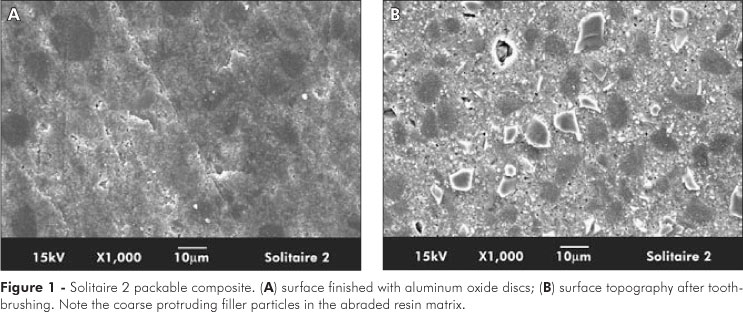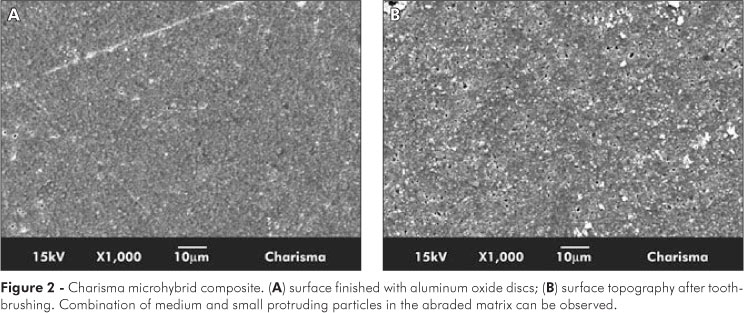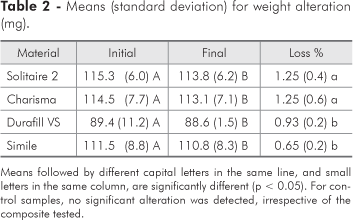Abstract
This study evaluated weight loss and surface roughening after toothbrushing of different resin composites: one packable (Solitaire 2, Heraeus Kulzer), one microhybrid (Charisma, Heraeus Kulzer), one nanohybrid (Simile, Pentron) and one microfilled (Durafill VS, Heraeus Kulzer). Cylindrical specimens (n = 20) were prepared. Half of the samples were submitted to 60,000 strokes, at 4 Hz, with a dentifrice-water slurry. Control samples (n = 10) remained stored at 37°C. Pre- and post-abrasion parameters for weight (mg) and surface roughness (Ra, µm) were determined on an analytical balance and a surface profilometer. Data were separately submitted to Repeated Measures ANOVA and Tukey's test (a = 0.05). Percentages of weight loss were analyzed by ANOVA and Tukey's test (a = 0.05). The relationship between both evaluations was assessed by Pearson's test (a = 0.05). The means (%) for weight loss (standard deviation) were 0.65(0.2), 0.93(0.2), 1.25(0.6) and 1.25(0.4) for Simile, Durafill, Charisma and Solitaire, respectively. Baseline roughness means ranged from 0.065(0.01), 0.071(0.01), 0.066(0.02) and 0.074(0.01) for Simile, Durafill, Charisma and Solitaire, respectively, to 0.105(0.04), 0.117(0.03), 0.161(0.03) and 0.214(0.07) after testing. The composites with larger fillers presented higher weight loss and roughening than the finer materials (p < 0.05). For both evaluations, control specimens showed no significant alteration. No significant relationship between loss of weight and roughness alteration was detected (r = 0.322, p = 0.429).
Composite resins; Surface properties; Physical properties; Toothbrushing
ORIGINAL ARTICLES
DENTAL MATERIALS
In vitro toothbrushing abrasion of dental resin composites: packable, microhybrid, nanohybrid and microfilled materials
Rafael Ratto de MoraesI; Daiane dos Santos RibeiroII; Mirian Margarete KlumbII; William Cunha BrandtI; Lourenço Correr-SobrinhoIII; Márcia BuenoIV
IGraduate Students
IIUndergraduate Students
IIIPhD, Professor - Department of Restorative Dentistry, Dental Materials Area, Piracicaba Dental School, State University of Campinas, Brazil
IVPhD, Professor, Department of Restorative Dentistry - School of Dentistry, Federal University of Pelotas, Brazil
Corresponding author Corresponding author: Márcia Bueno Faculdade de Odontologia Universidade Federal de Pelotas R. Gonçalves Chaves, 457, Centro Pelotas - RS - Brazil CEP: 96015-560 E-mail: mbuenop@terra.com.br
ABSTRACT
This study evaluated weight loss and surface roughening after toothbrushing of different resin composites: one packable (Solitaire 2, Heraeus Kulzer), one microhybrid (Charisma, Heraeus Kulzer), one nanohybrid (Simile, Pentron) and one microfilled (Durafill VS, Heraeus Kulzer). Cylindrical specimens (n = 20) were prepared. Half of the samples were submitted to 60,000 strokes, at 4 Hz, with a dentifrice-water slurry. Control samples (n = 10) remained stored at 37°C. Pre- and post-abrasion parameters for weight (mg) and surface roughness (Ra, µm) were determined on an analytical balance and a surface profilometer. Data were separately submitted to Repeated Measures ANOVA and Tukey's test (a = 0.05). Percentages of weight loss were analyzed by ANOVA and Tukey's test (a = 0.05). The relationship between both evaluations was assessed by Pearson's test (a = 0.05). The means (%) for weight loss (standard deviation) were 0.65(0.2), 0.93(0.2), 1.25(0.6) and 1.25(0.4) for Simile, Durafill, Charisma and Solitaire, respectively. Baseline roughness means ranged from 0.065(0.01), 0.071(0.01), 0.066(0.02) and 0.074(0.01) for Simile, Durafill, Charisma and Solitaire, respectively, to 0.105(0.04), 0.117(0.03), 0.161(0.03) and 0.214(0.07) after testing. The composites with larger fillers presented higher weight loss and roughening than the finer materials (p < 0.05). For both evaluations, control specimens showed no significant alteration. No significant relationship between loss of weight and roughness alteration was detected (r = 0.322, p = 0.429).
Descriptors: Composite resins; Surface properties; Physical properties; Toothbrushing.
Introduction
Resin-based restoratives are increasingly being used in dentistry, and the continual development of materials has made a variety of tooth-colored composites available for clinical use. These present a wide range of organic and inorganic components that may affect both their handling characteristics and properties.
The most traditional composites for restorative purposes are hybrid and microfilled, generally containing filler particles ranging from 0.5 to 4 µm, and 0.02 to 0.09 µm, respectively. Packable composites were introduced with the so-called advantage of allowing the material to be compacted into the cavity. More recently, nanofilled and nanohybrid composites were introduced, in an attempt to provide a restorative material that could be used in both anterior and posterior areas, presenting high initial polishing combined with superior polish and gloss retention.1
The long-term clinical service of composite fillings depends on their physical characteristics. One of the most important properties is the ability to withstand wear, as any loss of substance could result in altering the anatomic shape and affecting the performance of restorations. Although clinicians tend to concentrate on occlusal wear, some researchers have demonstrated that the abrasion process produced by oral hygiene methods can adversely affect the surface characteristics of restoratives.2-6 Therefore, this process could interfere with both health and esthetics, as rough surfaces may predispose to biofilm accumulation and extrinsic staining.
Several studies have evaluated the wear of resin-based restoratives.2,4-11 Nonetheless, as literature presents controversial findings, assessment on the abrasion resistance of materials presenting different inorganic compositions is warranted. Therefore, the aim of this study was to evaluate the loss of weight and alteration in surface roughness of dental composites, with different inorganic matrix compositions, submitted to toothbrush abrasion. The relationship between loss of weight and surface roughening was also investigated.
Material and Methods
Four commercial resin composites, presenting differences in inorganic matrix composition, were tested: one packable, one microhybrid, one nanohybrid, and one microfilled. The materials' compositions are shown in Table 1. Twenty samples per composite were obtained. The materials were placed in cylindrical elastomer molds (5 mm inner diameter x 2 mm thick) in three increments, and each increment was light-activated for 40 s (XL3000 - 3M ESPE, St. Paul, MN, USA, 480 mW/cm²) from the top surface.
After 24 h storage in distilled water, at 37°C, the specimens were polished with medium, fine and superfine aluminum oxide discs (Sof-Lex system, 3M ESPE). The samples were ultrasonically cleaned (MaxiClean 750, Unique, Indaiatuba, SP, Brazil) in distilled water for 10 min, and dry-stored at 37°C, to allow the weight of the specimens to stabilize. In order to obtain the pre-brushing weight value (w1), the samples were weighed every 24 h on an analytical digital balance (Chyo JK-180, Chyo Balance Corp., Tokyo, Japan), with 0.1 mg accuracy, until a constant weight was obtained. Baseline surface roughness readings were taken by rotating the specimens, clockwise at random angles, through a surface profilometer (Surfcorder SE1700, Kosaka Lab., Tokyo, Japan), equipped with a diamond stylus (0.5 µm tip radius) and accurate to 0.01 µm. Five traverses of the stylus were made across the diameter of each sample. The mean roughness parameter (Ra, µm) was recorded as the average of the five readings.
Ten specimens per composite were submitted to the abrasion test in a multi-station brushing device. Each sample was brushed at a different station with a soft, nylon-bristled toothbrush (Colgate Classic, 32 tufts, 60 bristles per tuft), under a brush-head load of 200 g. The specimens were immersed in slurry of dentifrice (Colgate, São Bernardo do Campo, SP, Brazil) and distilled water (1:2 wt:wt ratio). In total, 60,000 strokes (complete forward and reverse movement) were performed at a frequency of 4 Hz. For each material, the remaining 10 samples were stored at 37°C throughout the study, defining the control groups.
After testing, the specimens were cleaned with a 1 min air/water spray, followed by a 10 min ultrasonic bath, and dried at 37°C for constant weight (w2). Surface roughness and weight parameters were determined anew. Loss of weight was calculated as the difference between w1 and w2, and expressed in percentage. In order to compare pre- and post-abrasion weight and surface roughness parameters, the data were submitted to Repeated Measures ANOVA and Tukey's test. In addition, to assess differences in weight alteration, the percentage of weight loss was analyzed by one-way ANOVA and Tukey's test. Relationship between weight loss and surface roughness alteration was assessed by Pearson's correlation test. All statistical procedures were performed at a significance level of a = 0.05. Additionally, brushed and polished specimens (n = 5 per material) were coated with gold and examined by SEM (JSM 5600LV, Jeol Inc., Peabody, MA, USA).
Results
Table 2 shows the results for weight alteration. All materials presented a significant decrease in weight when comparing the values before and after abrasion (p < 0.05). However, significant differences among the materials were detected. Solitaire 2 and Charisma presented higher weight loss than Durafill VS and Simile (p < 0.05), whereas the microfilled and the nanohybrid restoratives showed similar results to each other. Moreover, no significant weight alteration was detected for the control samples.
Table 3 displays the outcomes of the profilometric analysis. All materials presented a significant increase in surface roughness after toothbrushing (p < 0.05). Despite the similar baseline values for all composites, composite Solitaire 2 showed significantly rougher surfaces after toothbrushing than the other restoratives. Furthermore, Charisma presented significantly rougher surfaces in comparison with Simile and Durafill VS (p < 0.05). On the other hand, no significant differences in post-abrasion surface roughness between Simile and Durafill VS were detected, and no significant alteration was observed for the control specimens, irrespective of the material tested.
No significant relationship between loss of weight and surface roughness alteration was detected (r = 0.322, p = 0.429). In the SEM analysis of polished specimens, smooth surfaces were observed, although scratches were present owing to the finishing procedures (Figures 1A, 2A, 3A and 4A). In contrast, SEM observation of abraded specimens revealed altered surfaces for all composites (Figures 1B, 2B, 3B and 4B). A combination of filler exposure, loss of inorganic particles and resin matrix wear was detected. However, Durafill VS showed the least altered surface after toothbrushing (Figure 4B).
Discussion
The major factors interfering with abrasion damage are the dentifrice and the toothbrush characteristics. The dentifrice is influenced by the abrasive type and size, and the slurry dilution, while the toothbrush depends on the number, rigidity and shape of tufts and bristles.8,12 However, since the above parameters were standardized for all groups in the present investigation, the abrasion resistance of the materials seems to depend on their inherent properties. There have also been reports about differences in wear resistance among composites, resulting from a combination of factors, such as filler features, organic matrix components, elastic modulus and hardness.7,13 Among these parameters, load, shape and size of fillers can be stated as the major characteristics interfering in the abrasion process.7,11
According to the current outcomes, the composites with larger fillers disclosed significantly higher weight loss than composites with finer particles. Indeed, it is known that small fillers enhance the packing of particles, producing composites with shorter inter-particle spacing. This provides better protection for the resin matrix, generally improving the abrasion resistance of the material.7,13 Therefore, since the toothbrushing wear results from a combination of factors, such as resin erosion, debonding of resin-filler interfaces and filler loss, the larger the size of the lost particles, the greater the resulting decrease in weight.
The profilometric investigation corroborates the outcomes of the weight analysis. Although all restoratives showed similar baseline roughness results, the packable composite showed the roughest surface after toothbrushing. In addition, the microhybrid material presented significantly rougher abraded surfaces compared with both the nanohybrid and microfilled composites. These outcomes indicate that the loss of particles contributed not only to weight alteration, but also to roughening. Surface roughness is determined by the size of inorganic particles presented within the composite. Therefore, the larger the size of the fillers lost during abrasion, the greater the increase in roughness.
SEM examination after toothbrushing showed that the packable (Figure 1B) and the microhybrid (Figure 2B) materials displayed a typical picture of protruding particles in an abraded matrix. In comparison, a slightly smoother surface was observed in the nanohybrid restorative (Figure 3B). On the other hand, SEM observation showed that the microfilled material had the least altered surface after toothbrushing (Figure 4B). This is probably related to the "organic filler" approach used in the microfilled composite manufacturing process, whereby filler and resin are mixed, cured, crushed and used for filling the final material.14 Therefore, during abrasion, the microfilled composite probably did not undergo inorganic particle debonding and elution, as the conventional materials did, which could explain the slight alterations observed by SEM. Nonetheless, a significant roughening after toothbrushing was also observed for this material.
An explanation for the loss of fillers during wear was reported by Hu et al.9 (2003). According to the authors, a combination of normal loading and frictional shearing forces act on the wear surface. However, as fillers present higher elastic modulus than the resin matrix itself, they may bear the majority of these loads. Nonetheless, owing to the relatively weak bond between fillers and resin, most particles cannot withstand the combined action of normal and frictional forces. Thus, they are liable to be fragmented or dislodged. With an increasing dislodgement of fillers, fatigue cracks are more easily induced, and they develop between fillers and organic matrix. Therefore, the integrity of this matrix is gradually destroyed, causing the loss of material.
Even though both the nanohybrid and the microfilled composites showed less surface roughening and lower loss of weight than the packable and the microhybrid materials, their performance was similar. Nanocomposites were introduced with the so-called advantage of increased polish and gloss retention, as only small particles would be dislodged during wear, leaving the surfaces with defects smaller than the wavelength of light.1 The main probable reason for the similarity presented by the nanohybrid and the microfilled restoratives is that while nanofilled composites use nanosized particles throughout the resin matrix, nanohybrids take the approach of combining nanomeric and conventional fillers.14 Thus, as evidenced by the present results, nanohybrids may still suffer from the loss of large particles. Therefore, it becomes questionable whether the Simile material can be defined as a "nanofiller loaded resin composite", considering that the size of fillers is similar to that of typical microfilled materials.
Both weight loss and changes in surface profile after abrasion have been previously reported,2,3,6 and each factor has been determined to be useful for measuring the effects of toothbrushing. Although Kanter et al.3 (1982) found that composites most prone to weight loss showed the greatest increase in surface roughness, the present findings corroborate an investigation6 that indicates that these evaluations do not present a significant relationship.
The materials assessed here presented different outcomes for weight loss and surface changes, and it is clear that the mechanisms accounting for these phenomena are more complex than can be explained by filler components alone. Although a significant weight alteration was detected for all composites, it is difficult to predict whether an average loss of 1% could be related to long-term alteration of anatomic form of fillings. However, from a clinical standpoint, the roughening effect could be rather significant, and the materials with finer particles showed lower roughening. Nevertheless, the conditions established here did not take into account the effects that variations in pH and temperature, the presence of plasticizing agents and mechanical fatigue, and the interaction of other stresses could have on the clinical situation. Therefore, further evaluations concerning this subject are required.
Conclusion
The toothbrushing abrasion caused significant weight loss and surface roughening for all materials. The nanohybrid and the microfilled composites presented similar results, showing lower weight loss and less roughening than both the packable and the microhybrid materials.
Received for publication on Sep 22, 2006
Accepted for publication on Jun 22, 2007
- 1. Mitra SB, Wu D, Holmes BN. An application of nanotechnology in advanced dental materials. J Am Dent Assoc. 2003;134(10):1382-90.
- 2. Garcia FC, Wang L, D'Alpino PH, Souza JB, Araujo PA, Mondelli RF. Evaluation of the roughness and mass loss of the flowable composites after simulated toothbrushing abrasion. Braz Oral Res. 2004;18(2):156-61.
- 3. Kanter J, Koski RE, Martin D. The relationship of weight loss to surface roughness of composite resins from simulated toothbrushing. J Prosthet Dent. 1982;47(5):505-13.
- 4. Rios D, Honorio HM, de Araujo PA, Machado MA. Wear and superficial roughness of glass ionomer cements used as sealants, after simulated toothbrushing. Pesqui Odontol Bras. 2002;16(4):343-8.
- 5. van Dijken JW, Ruyter IE. Surface characteristics of posterior composites after polishing and toothbrushing. Acta Odontol Scand. 1987;45(5):337-46.
- 6. Wang L, Garcia FC, Araujo PA, Franco EB, Mondelli RF. Wear resistance of packable resin composites after simulated toothbrushing test. J Esthet Restor Dent. 2004;16(5):303-14.
- 7. Condon JR, Ferracane JL. Factors effecting dental composite wear in vitro J Biomed Mater Res. 1997;38(4):303-13.
- 8. de Gee AJ, ten Harkel-Hagenaar HC, Davidson CL. Structural and physical factors affecting the brush wear of dental composites. J Dent. 1985;13(1):60-70.
- 9. Hu X, Marquis PM, Shortall AC. Influence of filler loading on the two-body wear of a dental composite. J Oral Rehabil. 2003;30(7):729-37.
- 10. Kawai K, Iwami Y, Ebisu S. Effect of resin monomer composition on toothbrush wear resistance. J Oral Rehabil. 1998;25(4):264-8.
- 11. Nagarajan VS, Jahanmir S, Thompson VP. In vitro contact wear of dental composites. Dent Mater. 2004;20(1):63-71.
- 12. De Boer P, Duinkerke AS, Arends J. Influence of tooth paste particle size and tooth brush stiffness on dentine abrasion in vitro Caries Res. 1985;19(3):232-9.
- 13. Jorgensen KD. Restorative resins: abrasion vs. mechanical properties. Scand J Dent Res. 1980;88(6):557-68.
- 14. Nanocomposites. J Esthet Restor Dent. 2005;17(1):3-4.
Publication Dates
-
Publication in this collection
20 Oct 2009 -
Date of issue
June 2008
History
-
Received
22 Sept 2006 -
Accepted
22 June 2007








